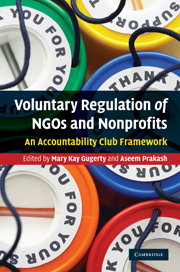Book contents
- Frontmatter
- Contents
- List of figures
- List of tables
- Notes on contributors
- Preface
- The club framework
- Part I Club emergence
- 2 Filling the gaps in nonprofit accountability: applying the club perspective in the US legal system
- 3 Trends and patterns in third-party accreditation clubs
- 4 Self-regulation at the state level: nonprofit membership associations and club emergence
- Part II Club sponsorship and club design
- Part III Club design and effectiveness
- Future research and conclusions
- Index
- References
4 - Self-regulation at the state level: nonprofit membership associations and club emergence
from Part I - Club emergence
Published online by Cambridge University Press: 10 November 2010
- Frontmatter
- Contents
- List of figures
- List of tables
- Notes on contributors
- Preface
- The club framework
- Part I Club emergence
- 2 Filling the gaps in nonprofit accountability: applying the club perspective in the US legal system
- 3 Trends and patterns in third-party accreditation clubs
- 4 Self-regulation at the state level: nonprofit membership associations and club emergence
- Part II Club sponsorship and club design
- Part III Club design and effectiveness
- Future research and conclusions
- Index
- References
Summary
Concerns about unethical and poor performance in the nonprofit sector have led to discussions of accountability and regulation, along with varied attempts to promote principles of best practice, codes of conduct, and ethical guidelines for the sector. Incentives are being crafted to encourage organizations to adopt specific practices beyond what is legally or administratively required (Gugerty, 2009). The sources of standards for practice include watchdog agencies such as the Better Business Bureau, agencies attempting to serve as the voice of the sector such as Independent Sector, and others. Attempts to shape nonprofit organizations have included simple statements of best practices, basic codes of ethics, customized standards of practice, and comprehensive certification programs. The specificity of the guidelines offered and the mechanisms for monitoring compliance vary greatly. No set of standards or principles has achieved a level of prominence and acceptance that suggests it has become widely institutionalized. What appear to be among the most endorsed and democratically produced efforts (e.g., The Donor Bill of Rights, The Accountable Nonprofit Organization, and Independent Sector's ethical guidelines) have all been characterized as failing miserably (Bothwell, 2001). Not only may bad behavior go uncorrected if standards and principles are not enforceable, the principles themselves may be criticized for not allowing adequate flexibility or, conversely, for being too vague.
In the business sector, accountability programs created and managed through industry and trade associations to signal members' quality and adherence to standards have come under increasing scrutiny by researchers.
- Type
- Chapter
- Information
- Voluntary Regulation of NGOs and NonprofitsAn Accountability Club Framework, pp. 85 - 98Publisher: Cambridge University PressPrint publication year: 2010
References
- 2
- Cited by



